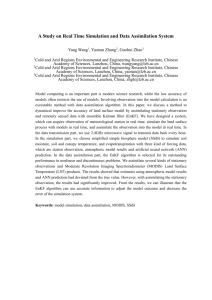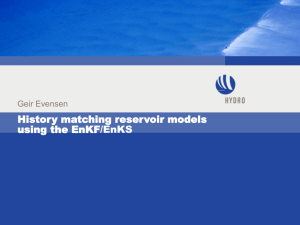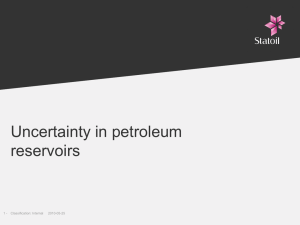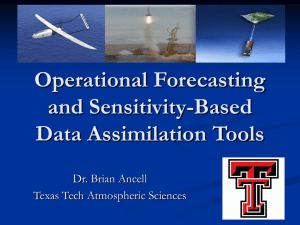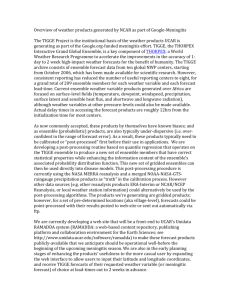Using an Ensemble Kalman Filter to Explore Model Performance on
advertisement
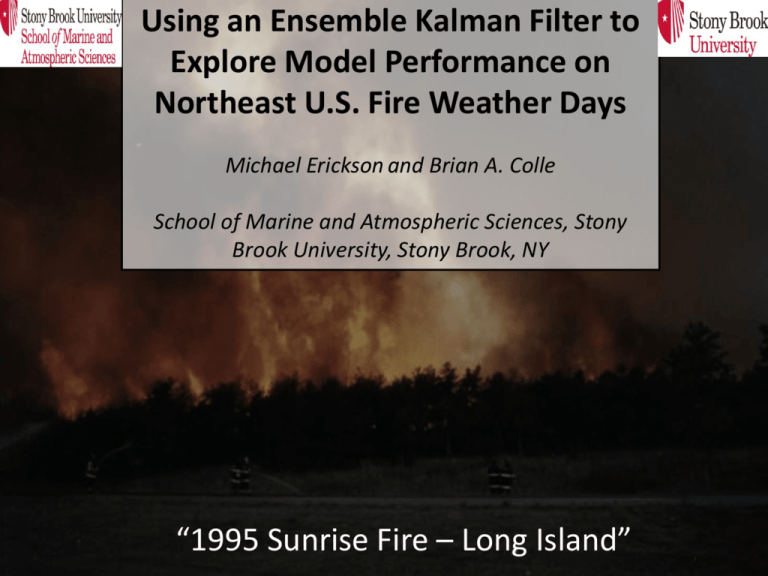
Using an Ensemble Kalman Filter to Explore Model Performance on Northeast U.S. Fire Weather Days Michael Erickson and Brian A. Colle School of Marine and Atmospheric Sciences, Stony Brook University, Stony Brook, NY “1995 Sunrise Fire – Long Island” What’s a Fire Weather Day? •A fire weather day is determined from a Fire Weather Index (FWI). Domain •The FWI is a statistical model that uses near-surface weather variables to predict the probability of wildfire occurrence. •Several near-surface weather variables are tested using observed fire occurrence data between 1999-2008. • Relative humidity and temperature are the only predictors in the FWI. Temperature Source: news12.com What’s a Fire Weather Day? •The FWI predicts the probability of wildfire occurrence using only temperature and relative humidity. •The FWI has reliable probabilities of wildfire occurrence using independent verification. •Using these probabilities, the index is defined as follows: 1. FWI = 1 has a wildfire occurrence probability between 30% and 40%. 2. FWI = 2 has a probability between 40% and 50%. 3. FWI = 3 has a probablility > 50%. • A Fire Weather Day has an FWI of greater than 1 (i.e. a 30% or greater chance of fire initiation). Reliability of Fire Weather Model …and compare that to what actually happened. In this case, 45% of the time a fire formed. Look at all of the cases where the model predicts a 45% chance of fire formation… Source: news12.com The Operational Fire Weather Index •The FWI is adapted to a model grid to create ensemble forecasts with the National Centers for Environmental Prediction (NCEP) Short Range Ensemble Forecast (SREF) system. •This SREF based forecast FWI is available operationally at: http://wavy.somas.stonybrook.edu/fire/ FWI Averaged By SREF Core FWI Ensemble Probabilities Source: news12.com Why Study Fire Weather Days? Model Bias on Fire Weather Days •Although rare, wildfires are dangerous due to a high population density. •A forecast FWI could produce reliable probabilistic fire weather forecasts. Model Error on Fire Weather Days •However, atmospheric models exhibit greater biases (too cold and too wet in the PBL) on fire weather days compared to climatology. •There are two ways to address this model bias: 1. Post-process model data via some regime capture method. 2. Explore potential sources of model bias using an Ensemble Kalman Filter. What is the Ensemble Kalman Filter? • The Ensemble Kalman Filter (EnKF) is a data assimilation technique that blends observations and a short-term ensemble of models to create a “bestof-both-worlds” analysis. • The Global Forecast System (GFS) has been initialized (partially) from an EnKF analysis since 2012. • An EnKF uses the variability in the ensemble of models to determine how assimilated observations should impact the analysis. • For instance, if a near-surface temperature observation assimilated ahead of a warm front is warmer than the ensemble mean, perhaps the impact of that observation should reflect the temperature structure of a faster warm front. 1000 hPa Temp and SLP Whitaker and Hamill 3DVAR Increment EnKF Increment Ensemble Kalman Filter Setup • This study uses the Pennsylvania State University (PSU) Ensemble Kalman Filter (EnKF) with forward iterations from the Weather Research and Testbed (WRF) model. Model Domain • Observations ingested include mesonet, ASOS, soundings, ACARS, profilers, maritime and satellite winds. Assimilated Observations • Model physics: ACM2 PBL scheme, GFS IC/LBCs, WSM6 microphysics, KF convection, RRTM (Dudhia) SW (LW) radiation. • Observations are assimilated using a 45member ensemble every 6-hours from 20120406 to 20120411. Initialized: 20120406 00 UTC First Obs. Assim 20120406 12 UTC 1-day EnKF Spin-up Simulation Concluded 20120411 00 UTC 4-day Verification Period Ensemble Kalman Filter Example – 20120409 at 18 UTC 6 Hr WRF Forecast 2-m Temperature, 10-m Wind and Sea Level Pressure EnKF Analysis 2-m Temperature, 10-m Wind and Sea Level Pressure Ensemble Kalman Filter – Trial Runs • The EnKF requires some “tuning” to optimize its performance. • Several runs were tested that adjusted the localization (radius of influence of the observations) and the impact of surface observations. These trial runs include: 1. Default run: 1300 km localization aloft, 200 km localization at the surface. 2. Same as 1) but with surface observations localization doubled. 3. Same as 1) but with surface observations localization halved. 4. No surface observations assimilated. 5. Observational error variance (i.e. confidence in the quality of the surface observations) reduced by half. • For simplicity, results will just be presented for temperature only. Region of Study Trial Run Results – Mean Error by Obs. Type 6 Hour WRF Forecast minus Observations EnKF Analysis minus Observations RUC Analysis minus Observations • Trial 5 is the least biased EnKF run in the Update and is comparable to the RUC. Trial Run Results – MAE by Obs. Type 6 Hour WRF Forecast MAE EnKF Analysis MAE RUC Analysis MAE • Trial 5 also has the lowest MAE at the surface compared to all other EnKF runs. Trial Run Results – MAE Vertical 6-hr WRF Forecast ACARS ACARS Profile • In the vertical, the largest error develops in the lower levels of the atmosphere for the 6-hour WRF forecast. Trial Run Results – MAE Vertical 6-hr WRF Forecast ACARS ACARS Profile • The EnKF analysis is comparable to or slightly better than the RUC. • Trial 5 (reduced surface observational error) is the best performing run. Optimal Run EnKF Performance on FWD’s – Mean Error 6 Hour WRF Forecast minus Observations EnKF Analysis minus Observations RUC Analysis minus Observations • Fire Weather Days have a colder (warmer) near-surface (aloft) model bias. Optimal Run EnKF Performance on FWD’s – MAE 6 Hour WRF Forecast MAE EnKF Analysis MAE RUC Analysis MAE • These biases impact mean absolute error, with the EnKF analysis comparable to or better than the RUC analysis. Optimal Run EnKF Performance on FWD’s – Spatial Mean Error For Mesonet Observations 6-hour WRF Forecast - Non-Fire Weather Days 6-hour WRF Forecast - Fire Weather Days • Spatially Fire Weather Days have a much greater cool bias, even for a 6 hour WRF forecast. Optimal Run EnKF Performance on FWD’s – Spatial Mean Error For Mesonet Observations EnKF Analysis - Non-Fire Weather Days EnKF Analysis - Fire Weather Days • The EnKF analysis corrects this cool bias in most locations. Optimal Run EnKF Performance on FWD’s – Spatial Mean Error For Mesonet Observations RUC Analysis - Non-Fire Weather Days RUC Analysis - Fire Weather Days • Although the RUC and EnKF analyses are comparable on the average, the RUC has a slight cool bias over Long Island. Optimal Run EnKF Performance on FWD’s – Spatial MAE for Mesonet Observations 6-hour WRF Forecast - Non-Fire Weather Days 6-hour WRF Forecast - Fire Weather Days • The cool bias on fire weather days negatively impact MAE. Optimal Run EnKF Performance on FWD’s – Spatial MAE for Mesonet Observations EnKF Analysis - Non-Fire Weather Days EnKF Analysis - Fire Weather Days • The EnKF in most cases reduces spatial MAE below 1oC. Optimal Run EnKF Performance on FWD’s – Spatial MAE for Mesonet Observations RUC Analysis - Non-Fire Weather Days RUC Analysis - Fire Weather Days • The RUC likewise reduces temperature MAE below 1oC . Take Home Points •A statistical Fire Weather Index (FWI) has been developed over the Northeast U.S. to reliably predict the probability of wildfire formation. •The FWI has been adapted for use with the Short Range Ensemble Forecast (SREF) and is available operationally. •Unfortunately model biases are greater on fire weather days, which can degrade operational fire weather forecasts. •An Ensemble Kalman Filter has been tested and optimized using the FWI to isolate fire weather days over the Northeast U.S. to explore potential sources of model error. Future Work •It is now time to put this EnKF to good use! The EnKF can be used to both estimate relevant parameters embedded in WRF model physics while creating an optimal analysis. Our next step will implement this technique to optimize parameters in the ACM2 PBL scheme within WRF.
